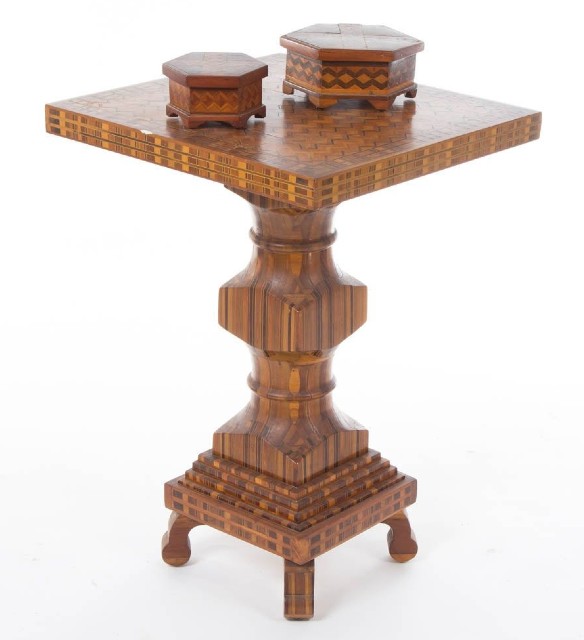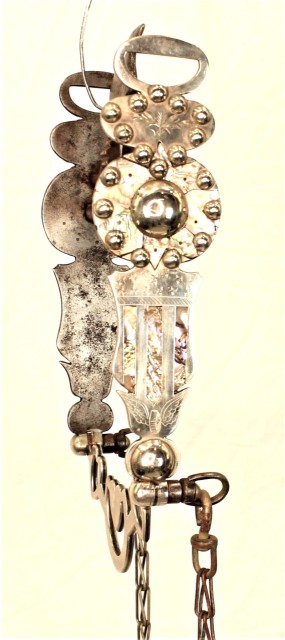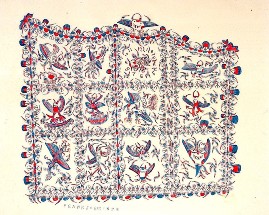
NEW YORK – Prison-made handicrafts have been a common practice for centuries as it kept the prisoners busy and gave them some purposeful activity while also serving as a profitable commercial enterprise for the prisons.
Quite a few of these types of items have been sought by collectors ranging from the iconic Napoleonic French prisoner of warship models, said to be carved from bones when meat was served them, to furniture and objects like silver spurs and horsetail bridles. Noncommercial art made by prisoners to while away their long confinement, often using found materials from popsicle sticks to prison documents, is also desirable. The latter takes many forms such as soap carvings, toothpick boxes and works on paper.
Prison artwork is a subject gaining interest to both collectors and the museum world. Several museums have explored this genre, including New York’s Museum of Modern Art, which mounted the 2020-21 exhibition, “Marking Time: Art in the Age of Mass Incarceration,” featuring work that shows how prisoners experiment with — and create art — amid their challenging daily lives and with material constraints that affect how and what kind of art they can make. Among prisoners-turned artists, whose work has been widely collected, are people like Frank Jones (above) and Harvey Ford whose abstracted and often symbolic drawings are often lumped into the field of Outsider Art. Some work is controversial, owing to the person’s crimes, but still collected.

Furniture-making in prison became a cottage industry of sorts. Woodworking opportunities were routinely provided at some prisons not to be altruistic but to make money while providing some purposeful activity for the men during their incarceration. Prisoner-made office furniture has furnished many American universities and in some states, state-run universities are required to source their furniture from local prisons.
Among prison-made furniture for the home, standouts include elaborate pieces that were likely commissioned pieces. A highlight is a massive table with seating for up to 12 known as the Gabaldon dining table. It was made by inmates at the Bilibid Prisons in the Philippines following World War II. “During the early days of the American occupation, the inmates of the Bilibid Prisons made household and office furniture as part of their rehabilitation and for income generation,” according to Salcedo Auctions, which sold the Gabaldon table in November 2017 for PHP 750,000 ($14,810) + the buyer’s premium. It noted the prison’s industrial division was said to have made elegant commissioned pieces such as that Neoclassical table with fine workmanship equal to the finest makers on the island.

Finely executed prison-made furniture was made in many countries and in the Southeast of the United States, prisoners were allowed access to woodworking tools such as hammers, saws, planes and pocketknives. One was Jeremiah Sidna Allen, who was sent to prison in Richmond, Virginia, for his part in a courtroom melee involving several of his family members in 1912. While incarcerated, he took on many woodworking projects, including the inlaid side table shown below, one of four tables he made there that likely each took over a year to make. Boasting highly detailed parquetry inlaid patterns all over, the table was finished in its natural colors.

While prisoners mainly created utilitarian objects for resale in prison workshops, several notable masters of their crafts specialized in artful objects. Convicted murderer John Cox began making spurs while serving a life sentence in Colorado’s Canon City Prison. His trademark on spurs was “Vallejo Star” but he is also renowned for his picks. A presentation and elaborately decorated prospector’s pick, circa 1903, is pictured here.

Known as the “Governor’s Pick,” this was a special order piece commissioned by Warden John Cleghorn to be presented to newly elected Colorado governor Jesse F. McDonald. Shown in a relief portrait on the pick handle are the governor with two friends, Theodore Roosevelt and Henry M. Teller. The finely engraved handle also has other portraits and local wildlife while silver inlays on the pick’s head depict animals and figural scenes.

Despite the less than the conducive atmosphere in prison for engaging in creative pursuits, prisoners have created art to express themselves and also learned workforce skills making handicrafts. Their craftsmanship has resonated on the outside world and can provide a unique look at life behind bars. Artists in prison have often said they didn’t set out to become an artist but felt compelled to make art and the process of making art in prison figuratively opens doors while opening minds to new opportunities, new connections and new ideas.
# # #


